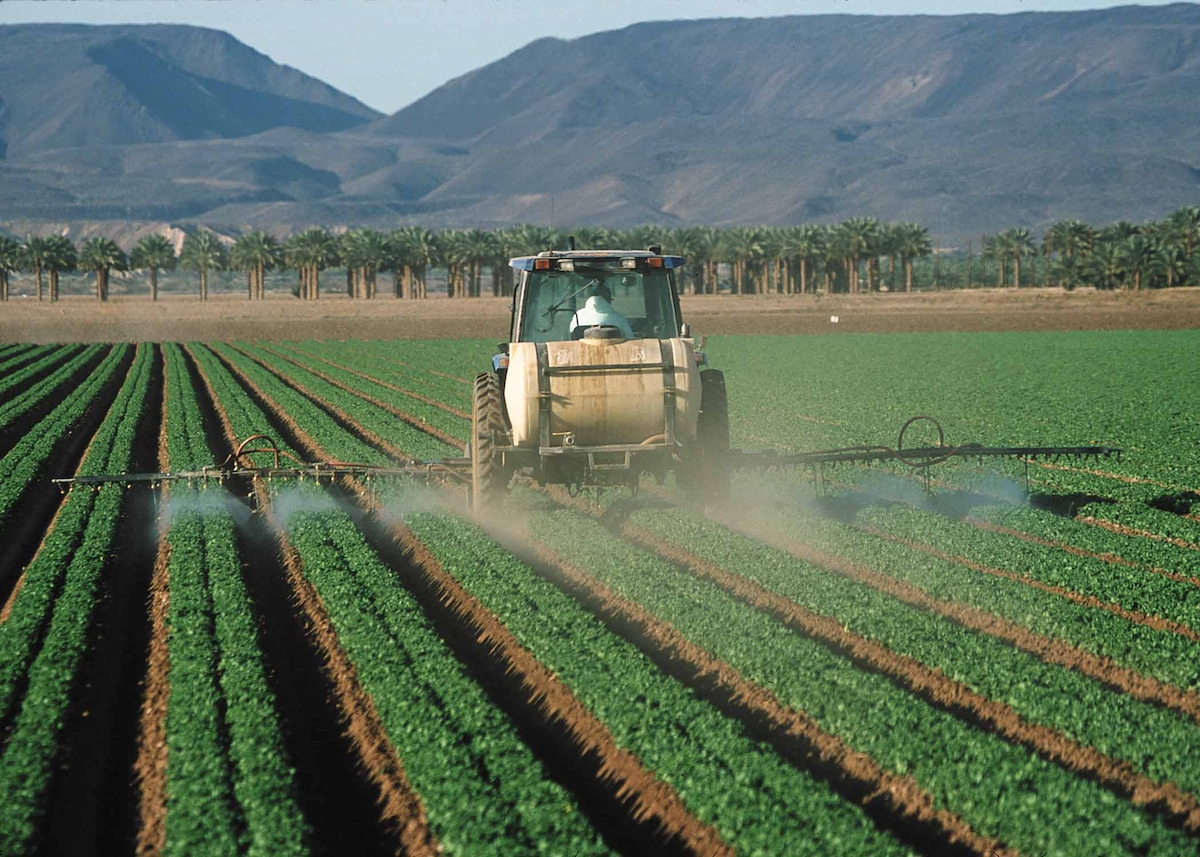Products You May Like
Pesticides are applied to many row crops, including lettuce, shown here. Jeff Vanuga / National Resource Conservation Service / U.S. Department of Agriculture
 Why you can trust us
Why you can trust us
Founded in 2005 as an Ohio-based environmental newspaper, EcoWatch is a digital platform dedicated to publishing quality, science-based content on environmental issues, causes, and solutions.
Toxic polyfluoroalkyl substances (PFAS) “forever chemicals” have been found in everything from products like cleaners, cosmetics and grease-resistant food packaging to air, water and soil — even in remote locations — as well as human blood.
Now, some of the most commonly used food pesticides in the U.S. have been found to be contaminated with these dangerous chemicals.
The results of new tests released by the Center for Biological Diversity and Public Employees for Environmental Responsibility (PEER) have found that the most frequently used insecticide in California, as well as two other pesticides, are contaminated with “potentially dangerous levels” of the harmful chemicals, a press release from the Center for Biological Diversity said.
More From EcoWatch
“I can’t imagine anything that could make these products any more dangerous than they already are, but apparently my imagination isn’t big enough,” said Nathan Donley, environmental health science director at the Center for Biological Diversity, in the press release. “The EPA has to take control of this situation and remove pesticide products that are contaminated with these extremely dangerous, persistent chemicals.”
The most widely used insecticide product in California is Intrepid 2F. The chemical is also the second most used pesticide in the state, with Roundup being the first. More than 1.7 million pounds of Intrepid were applied to over 1.3 million acres of land in California, according to data from 2021. Some of the crops it is most frequently applied to include peaches, almonds, pistachios and grapes.
The study found that three out of seven of the agricultural pesticides that were tested contained high levels of PFAS. One of them greatly exceeded the EPA’s safety limits for drinking water. Commissioned by the Center for Biological Diversity, the testing found no concentrations of PFAS above the detection limit in the two pesticide products for residential use that were assessed.
According to the groups that conducted the study, the results underscore the need for greater testing and removal of products contaminated with the chemicals.
“While communities around the country are struggling to remove PFAS from their drinking-water supplies, we are spraying millions of acres of our land with the same toxic chemicals,” said PEER’s science policy director Kyla Bennett, who is a scientist and attorney formerly with the EPA, in the press release. “It’s nonsensical; we can’t protect our drinking water unless and until we get PFAS out of all pesticides.”
PFAS have been associated with cancer, reduced fertility, liver damage, immune system suppression, obesity and thyroid disease. They do not break down in the environment and have been found in more than 330 animal species worldwide, many of which are at risk of extinction.
The level of perfluorooctanoic acid (PFOA) found in Malathion 5EC — a product containing the neurotoxin malathion — was found to be more than 100,000 times higher than what is considered safe in drinking water by the EPA.
The tests also showed that Oberon 2SC contained 1,500 parts-per-trillion (ppt) of perfluorobutanoic acid (PFBA), while Intrepid 2F had 350 ppt of perfluorobutanesulfonic acid (PFBS).
“There is no better way to poison Americans than contaminate our food supply and soils with PFAS, and the blame for this lies squarely on the shoulders of EPA,” Bennett said, as The Guardian reported. In 2020, Bennett was the first to discover PFAS in pesticides.
This was not the first study to have found PFAS in pesticides, the press release said. Separate tests conducted by the EPA, PEER and the Massachusetts Department of Environmental Protection previously found high levels of the toxins in mosquito insecticides sprayed in New York, Florida and Massachusetts.
PFAS have also been detected in some common flea and tick products.
Two of the forever chemicals — PFBS and PFHpS — have not been shown to leach from fluorinated containers, which is considered by the EPA to be the main source of PFAS contamination in pesticides.
The results of the recent tests suggest that at least some of the agricultural products are being contaminated with PFAS from unknown sources.
“The fact that we are likely spraying pesticides with PFAS on food at a time when EPA acknowledges there is no safe level of some of these chemicals is nonsensical,” Bennett said, as reported by The Guardian.
On Monday, the groups submitted their test results to the California Department of Pesticide Regulation and the EPA, requesting that they remove the products until the contaminants could be eliminated from their supply chains.
Subscribe to get exclusive updates in our daily newsletter!
By signing up, you agree to the Terms of Use and Privacy Policy & to receive electronic communications from EcoWatch Media Group, which may include marketing promotions, advertisements and sponsored content.
